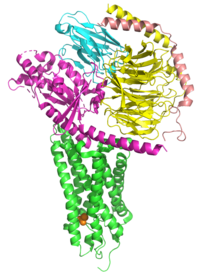
Photo from wikipedia
Upon strong and prolonged excitation, neurons can undergo a silent state called depolarization block that is often associated with disorders such as epileptic seizures. Here, we show that neurons in… Click to show full abstract
Upon strong and prolonged excitation, neurons can undergo a silent state called depolarization block that is often associated with disorders such as epileptic seizures. Here, we show that neurons in the peripheral olfactory system undergo depolarization block as part of their normal physiological function. Typically, olfactory sensory neurons enter depolarization block at odor concentrations three orders of magnitude above their detection threshold, thereby defining receptive fields over concentration bands. The silencing of high-affinity olfactory sensory neurons produces sparser peripheral odor representations at high-odor concentrations, which might facilitate perceptual discrimination. Using a conductance-based model of the olfactory transduction cascade paired with spike generation, we provide numerical and experimental evidence that depolarization block arises from the slow inactivation of sodium channels—a process that could affect a variety of sensory neurons. The existence of ethologically relevant depolarization block in olfactory sensory neurons creates an additional dimension that expands the peripheral encoding of odors.
Journal Title: Science Advances
Year Published: 2022
Link to full text (if available)
Share on Social Media: Sign Up to like & get
recommendations!